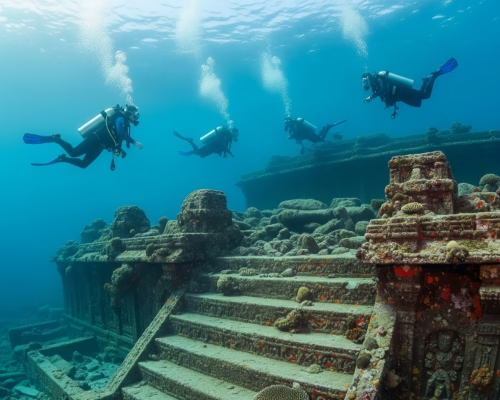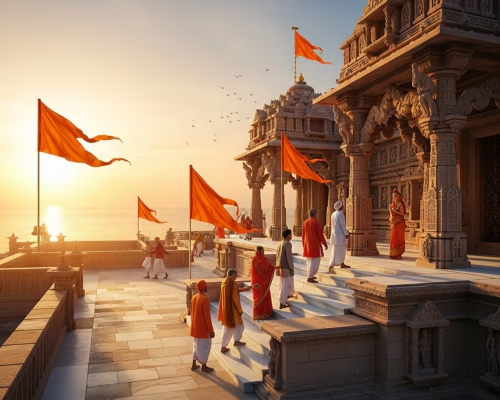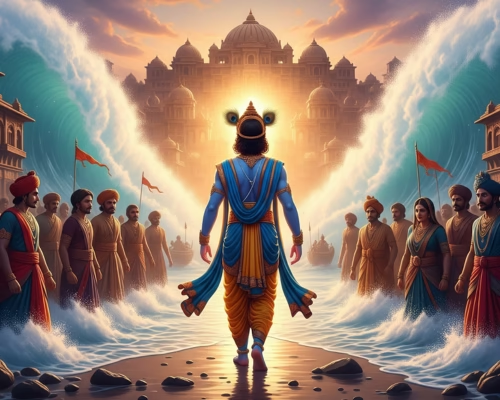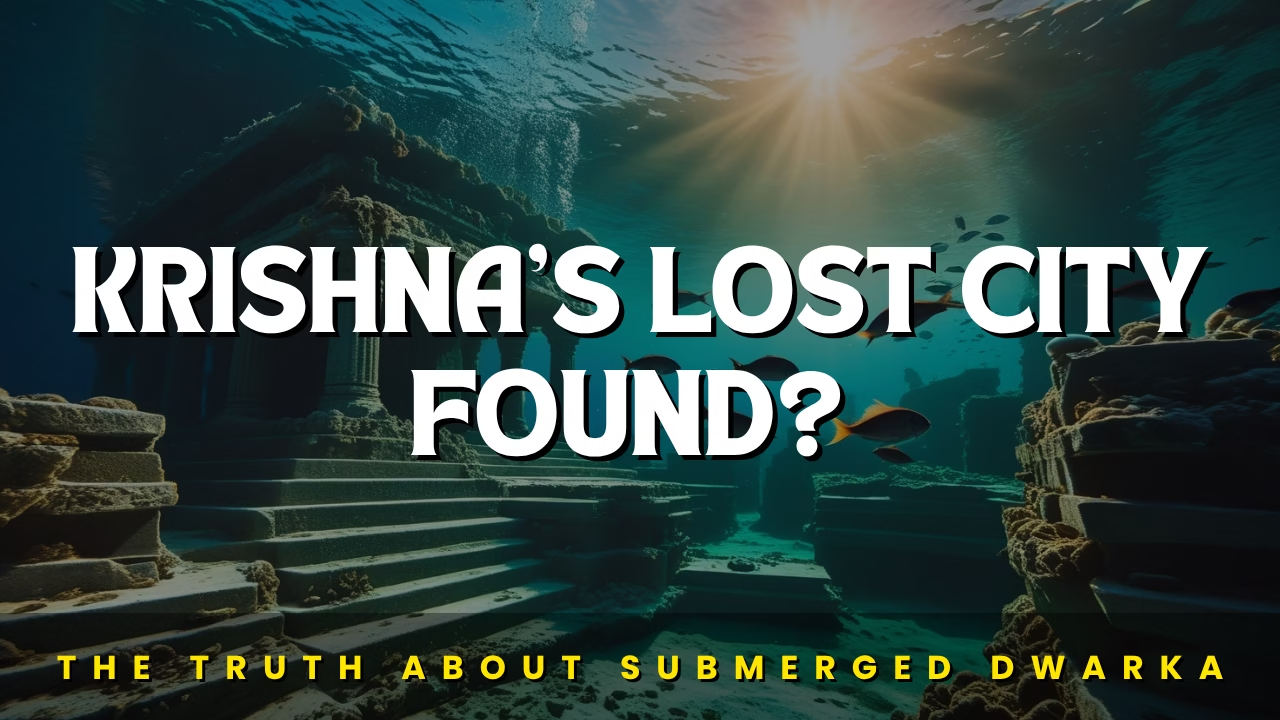A sunken city. A god-king. And waves that whisper secrets no one has fully decoded.
Off the western coast of India, in the Arabian Sea, lies the modern town of Dwarka — a bustling pilgrimage site. But beneath its waters may rest one of history’s greatest enigmas: the legendary city built by Lord Krishna himself. Ancient texts speak of Dwarka as a city so grand, it defied the imagination. Built overnight and later swallowed by the ocean, it sounds more like fantasy than fact. Or is it?
In recent years, divers have found submerged stone ruins, raising a haunting question: did a city once stand here — and sink just as the scriptures claim?
Let’s dive into the evidence, the legends, and the mysteries that surround Krishna’s Dwarka — where mythology and archaeology collide.
Table of Contents
Dwarka in Ancient Texts
Ancient Indian scriptures don’t just mention Dwarka — they describe it in staggering detail. According to the Mahabharata, the Harivamsa Purana, and the Skanda Purana, Dwarka wasn’t a typical city. It was a coastal metropolis with grand avenues, gardens, watchtowers, and palaces adorned with gold and silver.
The texts credit Vishwakarma, the divine architect of the gods, with constructing the city at Krishna’s request. But the clock was ticking — Krishna needed to relocate his people overnight to escape constant attacks from Jarasandha, king of Magadha. The scriptures claim that Vishwakarma complied, building the entire city in a single day.
Interestingly, these texts don’t portray Krishna solely as a divine figure. They present him as a strategist, a political leader who turned a vulnerable people into a maritime power. Ancient planners divided Dwarka into six sectors, built a central administrative zone, and designed a harbor to receive trade ships from afar.
Perhaps the most dramatic detail in these ancient sources is the city’s end. After Krishna left the mortal world, Dwarka was said to have been swallowed by the sea. No war, no decay — just a complete submergence, as if nature itself reclaimed what man and god built together.
Archaeological Discoveries
In 1983, a team from India’s National Institute of Oceanography set out to investigate the waters near present-day Dwarka. What they found changed the conversation from legend to possibility. Just 20–40 feet below the coast, divers found stone walls, steps, and foundations laid out in clear geometric patterns. These weren’t scattered rocks; they looked like remnants of a city.
Led by marine archaeologist Dr. S.R. Rao, the team uncovered anchors, pottery shards, and evidence of a jetty or wharf —suggesting the presence of a well-developed port. Some anchors weighed over 200 kilograms and were shaped to hold large sea vessels in place, hinting that the city had active maritime trade.
In 2002, a more advanced sonar survey in the Gulf of Khambhat (120 miles from Dwarka) revealed even more astonishing formations: massive stone blocks laid out in grids, long walls extending hundreds of meters, and submerged artifacts embedded deep in the seabed. Among them were pottery fragments, tools, and fossilized human remains.
The layout of the structures aligned eerily well with the descriptions found in ancient texts. A fortified urban grid. Harbor infrastructure. Water reservoirs. All beneath the sea, and thousands of years old.
These discoveries didn’t confirm that Krishna walked these streets — but they raised a serious question: What city existed here, before history started recording?

Carbon Dating and Controversy
When carbon dating results placed several recovered artifacts between 1500 BCE and 3000 BCE, archaeologists were both thrilled and puzzled. If accurate, these dates push the underwater remains back to a time before many major urban civilizations recorded in Indian textbooks — including parts of the Indus Valley Civilization.
But that’s where the controversy begins.
Skeptics argue that while the artifacts are undoubtedly ancient, there’s no definitive proof linking them to Krishna or to the Dwarka described in the Mahabharata. The critics label it as a classic case of “reverse archaeology” — starting with a legend and searching for evidence to validate it, rather than letting discoveries speak for themselves.
On the other hand, proponents like Dr. S.R. Rao believe that the convergence of dating, location, and architectural patterns is too precise to ignore. They point out that the Mahabharata, once considered entirely mythical, has proven historically valuable in other contexts — mentioning real rivers, tribes, and cities long before modern discovery confirmed them.
Adding fuel to the debate, some researchers believe the submerged ruins may even predate the Harappan cities, which would rewrite major parts of Indian history. If that’s true, these structures could represent a lost chapter of urban evolution on the subcontinent.
No matter the debate, the submerged ruins of Dwarka clearly show age, structure, and human craftsmanship — yet their full story remains untold.
Oceanography and Geological Shifts
The Arabian Sea hasn’t always looked the way it does today. Geological studies reveal that over the past 5,000 years, the sea level along the western coast of India has risen significantly — enough to submerge entire settlements. This isn’t just speculation; sediment cores taken from the Gulf of Khambhat and Dwarka coastline show clear evidence of rapid submergence events, likely caused by a mix of tectonic shifts and melting glaciers at the end of the last Ice Age.
Marine geologists also point to fault lines running beneath the seabed near Gujarat, which could have triggered earthquakes powerful enough to sink coastal structures. Combined with rising tides, such shifts could have gradually pulled a low-lying coastal city like Dwarka underwater, piece by piece — no need for divine wrath or supernatural floods.
Interestingly, similar legends of cities swallowed by the sea appear in other cultures as well. Atlantis in the West. Yonaguni in Japan. Even in Tamil folklore, Kumari Kandam is remembered as a lost landmass that once stretched across the Indian Ocean. These stories may have a common root: real cities consumed by ancient climate and tectonic changes.
In Dwarka’s case, the ocean might not just be a backdrop to mythology — it may be the last witness to a civilization time forgot.
Interesting Facts About Lost Dwarka
Crocodiles as Guards? Ancient texts mention that Dwarka had a moat filled not with water alone, but with live crocodiles to deter intruders. A natural security system few would dare to cross.
900,000 Palaces? The Harivamsa Purana describes Dwarka as a city of nine lakh palaces, each glittering with crystal, silver, and gold. While symbolic, the number hints at a population and infrastructure far beyond a tribal settlement.
Underwater Temple Bell Sounds: Local fishermen claim that on calm nights, they hear faint echoes — like temple bells — coming from beneath the sea. Scientists dismiss it as auditory illusion, but the stories persist.
Krishna’s Seaport Vision: Dwarka was one of the first cities in Indian mythology to have a functional seaport, indicating awareness of naval architecture long before historical maritime records.
The Seven Cities of Dwarka: Legends speak of seven Dwarkas, each destroyed and rebuilt over time. The current Dwarka is believed to be the last in that line — built on land reclaimed from the ocean.
Artifacts Still Wash Ashore: Locals frequently discover conch bangles, pottery shards, and ancient-looking figurines along the coastline — sparking amateur treasure hunts and plenty of folklore.
NASA’s “Satellite Proof” Theory: A widely circulated (but unverified) claim suggests that satellite imagery once captured symmetrical structures underwater near the Dwarka coastline. While dismissed by official agencies, the idea added fuel to global curiosity.
Dwarka is a ‘Sapta Puri’: It’s one of the seven most sacred pilgrimage cities in Hinduism, alongside Ayodhya and Varanasi. Yet, it stands alone as the only sacred city believed to have vanished beneath the sea.
Cultural Legacy
Dwarka isn’t just an underwater mystery — it lives on in temples, traditions, and festivals celebrated across India. The modern city of Dwarka in Gujarat, often called Gomti Dwarka, stands as a spiritual descendant of the sunken metropolis. Pilgrims arrive daily to visit the Dwarkadhish Temple, a towering 2,000-year-old shrine believed to be built over Krishna’s original palace site.
Every year, devotees commemorate Dwarka Punyatithi — the day the ocean is said to have claimed the original city. It’s not just a ritual but a remembrance of a civilization that once thrived by the sea and vanished without a trace.
Interestingly, the Jagannath Rath Yatra of Puri (in Odisha) also connects back to Dwarka through Krishna’s lore, forming a cultural triangle with Mathura and Dwarka as sacred destinations.
Indian classical dance and theatre, especially forms like Kuchipudi and Kathakali, have preserved stories from Krishna’s Dwarka era in performances — keeping the legacy alive through movement and music.
Even beyond religious circles, Dwarka has seeped into pop culture. From graphic novels to docu-series, filmmakers and writers continue to reimagine the lost city in everything from mythic epics to sci-fi thrillers. The idea of a god-king, a golden city, and a catastrophic submergence resonates far beyond temple walls.
Dwarka today is not just a place on the map — it’s a memory encoded in song, soil, and sea.

Conclusion: History or Mythology?
Dwarka sits at a rare crossroads — between scripture and science, belief and evidence. For centuries, it existed only in verses, woven into the epic life of Krishna. But today, sonar images, submerged structures, and unearthed artifacts force us to ask a deeper question: was this divine city ever just a myth?
The ruins off Gujarat’s coast don’t offer loud answers. They whisper. Through broken anchors, eroded walls, and pottery lost to time, they suggest a civilization more advanced than we assumed — and far older than our history books admit.
We may not be able to prove if Krishna walked these streets, but a city lost to the sea, preserved in memory, and found after millennia — that possibility feels real. That alone reshapes our understanding of how myth can preserve memory — and how oceans can keep secrets.
Sometimes, history hides in legend, waiting for the tide to retreat.

Explore more untold stories in our Forgotten Histories archive — where lost legacies come back to light.



